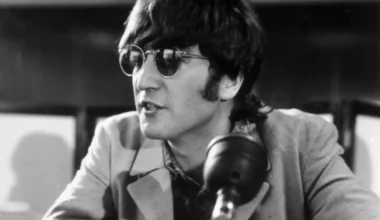David Gilmour, the guitarist for Pink Floyd, would probably scratch his head for a little while when asked which prog-rock classic is his favorite. No, because he would be looking for the perfect song to share with you instead of tactfully directing you to “do one”. Following the departure of a certain loud-voiced Mr. Waters from the group, the guitarist and vocalist became the official spokesperson. Consequently, he mostly had to handle such inquiries alone.
Being the modest man that he is, Gilmour usually declines to answer when asked which Pink Floyd song is his favorite, except the one time he listed six that he thought were the best. The standard fare is all there; “Echoes,” “Comfortably Numb,” and “The Great Gig in the Sky” are all mentioned. However, the first song he skipped over was “High Hopes” from The Division Bell. It immediately made him think of Pink Floyd’s greatest song of all time.
Pink Floyd came together for the 1994 album The Division Bell, despite the album’s name. The band put on a united front, even with an unannounced addition in the studio, even though Roger Waters had long since left the group and his attempts to have them cease as Pink Floyd had failed. The album marked the beginning of Polly Samson, Gilmour’s former girlfriend, contributing to the song’s production.
Officially, Pink Floyd had changed into something unrecognizable from their early work. Along with Waters’ departure, the group was introducing an increasing number of new members, including producer Bob Ezrin and a large group of session musicians. However, Gilmour and Samson’s friendship was crucial, as they co-wrote most of the album’s lyrics, shaping its essence.
In looking back on the album, David Gilmour said, “I started writing things and looking to her for an opinion. And gradually, as a writer herself and an intelligent person, she started putting her oar in, and I encouraged her.” Being a talented writer herself, Samson gave the songs a sense of harmony that had been inadvertently lacking. At his Thames-side studio/houseboat Astoria, Gilmour would work on music all day until coming home to Samson to start writing lyrics. It made it possible for the entire record to feature the rock & roll equivalent of nighttime elf labor. As Gilmour puts it, “There was a whole invisible side to the process.”
Without a doubt, “High Hopes” was the couple’s best song on the album. “It united the entire album,” stated producer Bob Ezrin. It also provided us with a concept to frame some of the more abstract ideas. The fact that the song was the last one the band completed for the LP is noteworthy. It was also the first they started assembling for the album, contributing significantly to its dependability. It implied that it was a consistent factor in their operations and offered consistency throughout the record.
After Douglas Adams selected lyrics from the second verse, it became the album’s second single and named The Division Bell. It makes sense, given that the song captures both the happy and sad times in Gilmour’s life, as well as his early years spent in Cambridge. Many have claimed that the song sounds like a breakup song, reflecting on the beginnings of the band’s discord. In actuality, Gilmour’s song was what brought the group together.
There were some grave concerns about Pink Floyd’s chances of success after Roger Waters left the group. Their first album released without Waters was A Momentary Lapse of Reason (1987), their thirteenth studio album. Although it’s not quite up to the Floyd standard—Waters referred to it as a “fair forgery.” It did demonstrate that the band could still be successful without their irascible frontman.
Without a doubt, David Gilmour was leading the charge and would continue to be so when the next record was released. Although Nick Mason and Richard Wright received equal credit for the musical ideas and concepts in the songs, the mantle of leadership had shifted. Gilmour and Samson primarily handled the lyrics. The guitarist who joined the band last was now firmly at the helm. This direct approach likely prolonged the band’s lifespan. For a group about to embark on their third decade together, it provided them with the necessary clarity of direction.
Whether or not “High Hopes” is Gilmour’s favorite song, it’s probably a stretch to put all of this on one track. However, the song perfectly captures the spirit of the album: one made by a band that plays as a unit.








